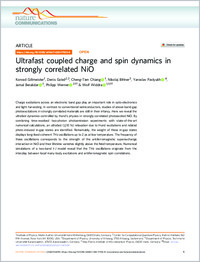Ultrafast coupled charge and spin dynamics in strongly correlated NiO
- Gillmeister, Konrad Institute of Physics, Martin-Luther-Universität Halle-Wittenberg, 06120 Halle, Germany
- Golež, Denis Center for Computational Quantum Physics, Flatiron Institute, 162 Fifth Avenue, New York NY 10010, USA - Department of Physics, University of Fribourg, 1700 Fribourg, Switzerland
- Chiang, Cheng-Tien Institute of Physics, Martin-Luther-Universität Halle-Wittenberg, 06120 Halle, Germany
- Bittner, Nikolaj Department of Physics, University of Fribourg, 1700 Fribourg, Switzerland
- Pavlyukh, Yaroslav Department of Physics, Technische Universität Kaiserslautern, 67653 Kaiserslautern, Germany
- Berakdar, Jamal Institute of Physics, Martin-Luther-Universität Halle-Wittenberg, 06120 Halle, Germany
- Werner, Philipp Department of Physics, University of Fribourg, 1700 Fribourg, Switzerland
- Widdra, Wolf Institute of Physics, Martin-Luther-Universität Halle-Wittenberg, 06120 Halle, Germany - Max Planck Institute of Microstructure Physics, 06120 Halle, Germany
-
14.08.2020
Published in:
- Nature Communications. - 2020, vol. 11, no. 1, p. 4095
English
Charge excitations across an electronic band gap play an important role in opto- electronics and light harvesting. In contrast to conventional semiconductors, studies of above-band-gap photoexcitations in strongly correlated materials are still in their infancy. Here we reveal the ultrafast dynamics controlled by Hund’s physics in strongly correlated photoexcited NiO. By combining time-resolved two-photon photoemission experiments with state-of-the-art numerical calculations, an ultrafast (≲10 fs) relaxation due to Hund excitations and related photo-induced in-gap states are identified. Remarkably, the weight of these in-gap states displays long-lived coherent THz oscillations up to 2 ps at low temperature. The frequency of these oscillations corresponds to the strength of the antiferromagnetic superexchange interaction in NiO and their lifetime vanishes slightly above the Néel temperature. Numerical simulations of a two-band t-J model reveal that the THz oscillations originate from the interplay between local many-body excitations and antiferromagnetic spin correlations.
- Faculty
- Faculté des sciences et de médecine
- Department
- Département de Physique
- Language
-
- English
- Classification
- Physics
- License
- License undefined
- Identifiers
-
- RERO DOC 329495
- DOI 10.1038/s41467-020-17925-8
- Persistent URL
- https://folia.unifr.ch/unifr/documents/308820
Other files
Statistics
Document views: 101
File downloads:
- wer_ucc.pdf: 174
- wer_ucc_sm.pdf: 119

